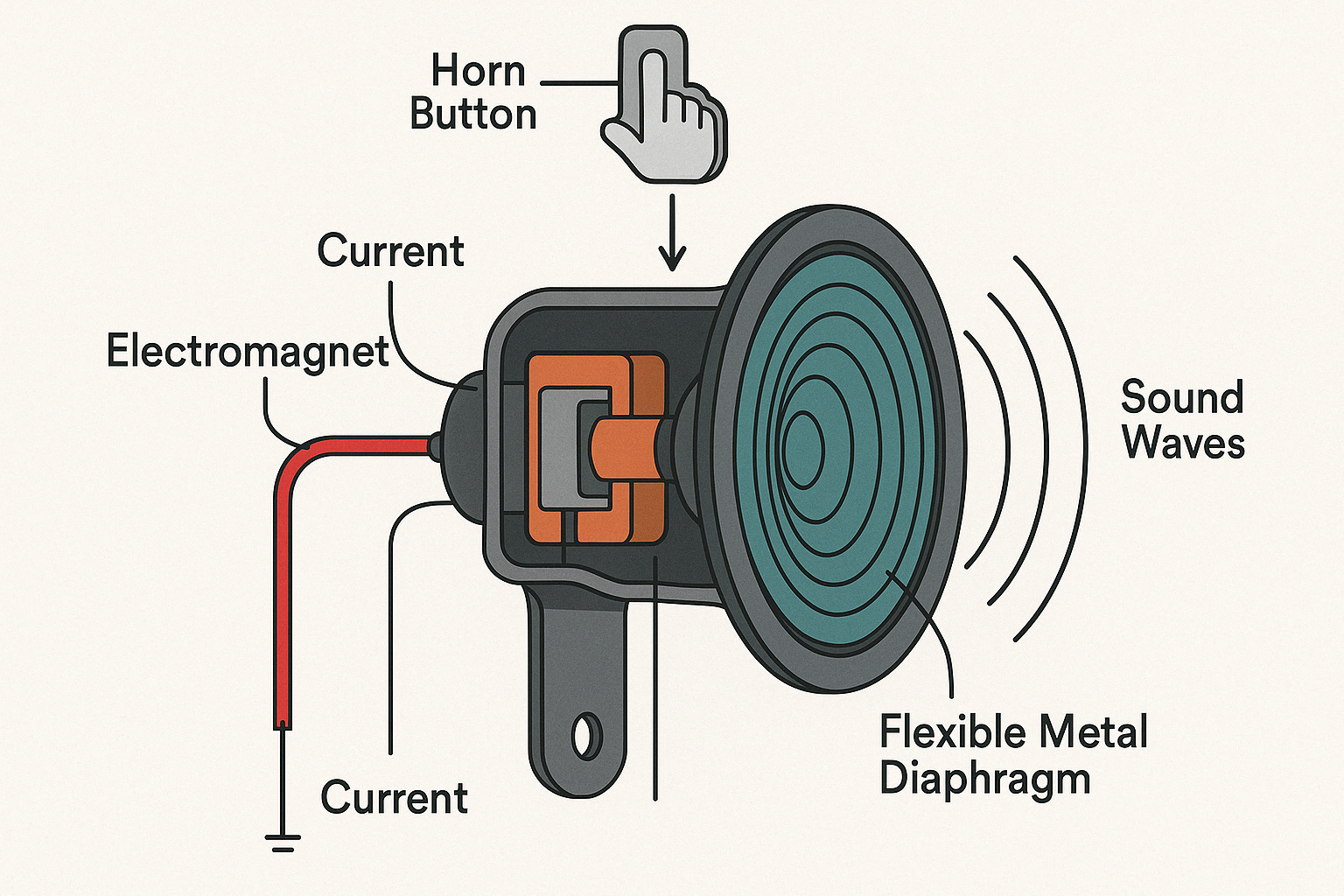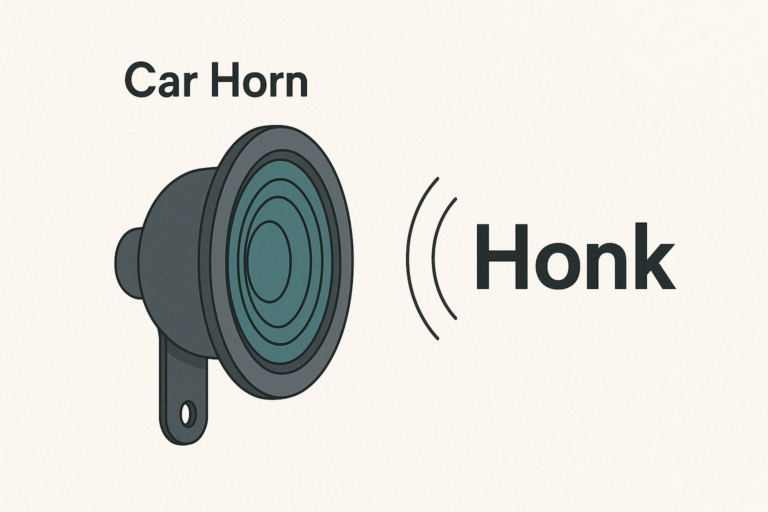Struggling to understand how car horns work? Knowing the basics helps you source reliable parts, avoiding costly quality issues down the line. It's all about simple mechanics.
The car horn's sound ("honk" or "beep") is created when electricity activates an electromagnet. This magnet rapidly vibrates a metal diaphragm, producing sound waves amplified by the horn's structure.
Understanding this core mechanism is just the start. There's a bit more detail involved in how that sound is produced and what we call it. Let's dive deeper into the specifics, starting with the name of the sound itself. Knowing the correct terms is always helpful in business.
What is the car horn sound called?
Ever worry you're using the wrong word for that noise? Clear communication prevents confusion, especially when discussing product specifications. Let's clarify the common terms used.
The sound from a car horn is most commonly called a "honk" or sometimes a "beep." These are onomatopoeias – words that imitate the actual sound they describe.
!
While "honk" is widely understood, the actual sound can vary quite a bit. Let's break down the terminology and why different horns sound different.
Common Terms
The most frequent words you'll hear are:
- Honk: This is the classic, most recognized term for the sound of a typical car horn. It usually implies a reasonably loud, medium-pitch sound.
- Beep: Often used for shorter, sometimes higher-pitched sounds. You might hear "beep the horn" instead of "honk the horn."
- Toot: A less common term, often implying a softer, shorter sound, perhaps from a smaller vehicle or a vintage car.
These words are based on how the sound strikes our ears – they are descriptive rather than technical.Why Different Sounds?
The specific sound depends heavily on the type of horn installed:
| Horn Type | Typical Sound Characteristic | Common Use |
|---|---|---|
| Disc Horn | Sharper, more direct "beep" or "honk" | Most passenger cars |
| Trumpet Horn | More resonant, louder, often lower pitch | Trucks, luxury cars |
| Air Horn | Very loud, deep, powerful blast | Large trucks, trains |
As a manufacturer, we at FHL GBSY JS-TECH understand these differences well. The design, materials, and size all influence the final sound frequency (pitch) and volume (loudness). When buyers like Jeremy from the Philippines specify their needs, knowing whether they want a standard "honk" or a more powerful trumpet sound helps us provide the exact product required. Understanding the nuances ensures you get a horn that meets market expectations.
What makes the honk sound in a car?
Unsure about the mechanics inside that horn? Knowing how it operates helps you evaluate quality and reliability when sourcing. Let's look at the components that actually create the noise.
An electromagnet is the heart of the horn. When you press the horn button, electricity activates this magnet, causing a flexible metal diaphragm to vibrate rapidly back and forth, creating sound waves.

This electromechanical process is quite clever. Let's break it down step-by-step to see how electricity turns into that familiar honk.
The Electrical Signal
It all starts when the driver presses the horn button on the steering wheel. This action completes an electrical circuit, allowing current (usually 12V in cars) to flow from the car's battery to the horn assembly. Without this electrical energy, nothing happens.
The Role of the Electromagnet
Inside the horn, the electrical current flows through a coil of wire wrapped around an iron core. This creates an electromagnet. The key feature here is that the circuit is designed with contact points that the electromagnet itself can interrupt.
- Current flows, electromagnet activates.
- The magnet pulls on a metal armature connected to the diaphragm.
- This movement breaks the electrical contact points, cutting power to the electromagnet.
- The magnet deactivates, releasing the armature/diaphragm.
- The armature springs back, remaking the electrical contact.
- Current flows again, and the cycle repeats rapidly.
Diaphragm Vibration Creates Sound
The diaphragm is a thin, flexible metal disc. As the electromagnet pulls and releases the armature connected to it (hundreds of times per second), the diaphragm vibrates vigorously. These vibrations push and pull the air, creating pressure waves – sound waves – that travel to our ears. In disc horns, the diaphragm itself often forms the outer casing, projecting the sound forward. In trumpet horns, the vibrations are channeled through a flared horn shape, which amplifies and shapes the sound, often giving it a lower pitch and greater carrying distance.
The quality of materials (like the diaphragm metal, coil wire, contact points) and the precision of manufacturing directly impact the horn's loudness, tone, and lifespan. At FHL GBSY JS-TECH, we focus on using high-quality components to ensure our horns perform reliably, comparable to brands like Bosch or Hella, and offer a 2-year guarantee. This focus on internal quality prevents issues like premature failure or inconsistent sound – critical factors for distributors supplying demanding markets.Is it car horn or honk?
Confusing the device with the sound it makes? Using precise language avoids misunderstandings in orders and technical discussions. Let's clearly define these two related terms.
"Car horn" refers to the physical device mounted in the vehicle that produces the sound. "Honk" is the actual sound produced by the horn when it is activated.

Understanding this simple difference helps communication, especially in a B2B context where product specifics are crucial. Let's explore why this distinction matters.
The Device: Car Horn
The term "car horn" refers to the tangible component. It's the part you purchase, install, or replace. It includes the electromagnet, diaphragm, housing, mounting brackets, and electrical connector. When discussing products, specifications, or inventory, you are talking about the car horn.
- Example: "We need to order 1,000 units of the FHL-12V disc car horn."
- Example: "Is the car horn certified for European markets?" (Addressing a pain point like Jeremy's concern about certification).
The Sound/Action: Honk
"Honk" primarily refers to the noise itself. It can also be used as a verb, meaning the action of activating the horn.
- Example (Sound): "That truck's honk was incredibly loud."
- Example (Action): "He honked at the car in front."
- Example (Action): "Honk the horn twice to signal."
| Term | Type | Meaning | Example Usage |
|---|---|---|---|
| Car Horn | Noun (Object) | The physical device | "I bought a new car horn." |
| Honk | Noun (Sound) | The noise the horn makes | "Did you hear that honk?" |
| Honk | Verb (Action) | To activate the car horn | "Honk if you agree." |
Why Does it Matter for Buyers?
For buyers, distributors, and wholesalers like Jeremy, using the terms correctly prevents confusion:
- Ordering: You order "car horns," specifying type (disc, trumpet), voltage, etc. You don't order "honks."
- Troubleshooting: A customer might complain about the "honk" being too weak, but the issue lies with the "car horn" itself.
- Specifications: Technical data sheets describe the performance of the "car horn" (e.g., dB level, frequency), which determines the quality of the "honk."
Clear communication avoids errors and saves time. When discussing custom branding or specific performance requirements with us at FHL GBSY JS-TECH, knowing you need a specific type of car horn that produces a particular kind of honk ensures we deliver exactly what you need for your market. This helps prevent the kind of inefficient communication that can frustrate buyers.Conclusion
So, the car horn is the device, and the honk is the sound. It works using an electromagnet vibrating a diaphragm. Understanding this helps choose quality horns for happy customers.


